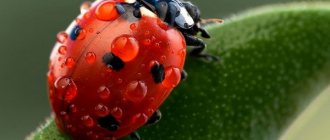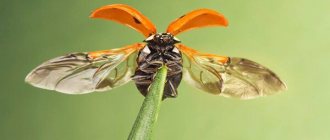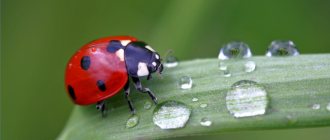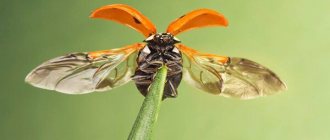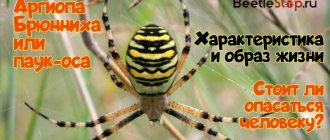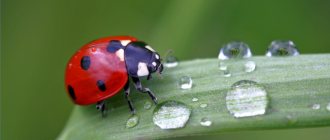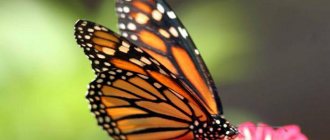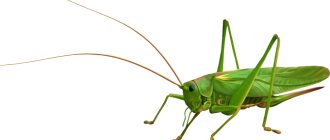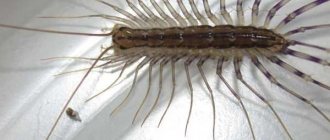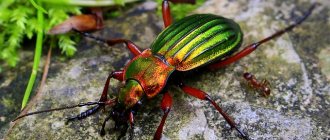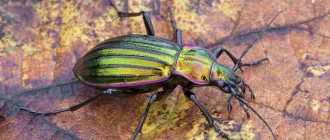Ladybug (lat. Coccinellidae) belongs to the family of beetles, a type of arthropod, a class of insects. When a person sees an insect, he involuntarily has a reaction - to slam it as quickly as possible, but the ladybug evokes sympathy in almost everyone, even women. Some remember a children's song associated with her, others remember that she really helps them out at their summer cottage - saving the garden from pests. What is the secret of everyone's sympathy for this beetle? In some cultures it is forbidden to kill a ladybug, and in the Western part it is generally considered a symbol of good luck. In many countries it is even included in the Red Book. Let's consider the characteristics and lifestyle of this insect, as well as the benefits and harms it can bring.
What does a ladybug look like?
Today, no more than 200 insect formations have been studied on the planet, but the number of species is limitless. The ladybug is a representative of the Coccinellidae family, has over 4000 types and 360 genera, and belongs to the order Coleoptera of the arthropod type. A distinctive feature from other relatives are the seemingly three-part legs. This is due to the small third segment, which is visually hidden with half of the fourth pedicle in the sinus of the bilobed process.
The average size of a ladybug is from 4 mm to 10 mm. The structure of the body is rounded, ovoid, flattened below and convex above. Sometimes the surface is covered with thin fibers.
The head is monolithically connected to the prothorax, everything looks like an enlarged cephalothorax. It makes up the main part of the body length, sometimes found in an elongated oval shape. The eyes are relatively large. The antennae are well flexible and consist of 8-11 segments.
Has rigid expressive elytra. Essentially these are the front flight organs. Over time, the ladybug's wings transformed. On the ground they perform a protective function. With the help of two rear processes, it flies, and it turns out quite well. It is interesting that various birds and many vertebrates do not dare to hunt it not only because of its toxicity. They do not have time to catch it, because the insect makes about 85 strokes per second.
Where does the name Ladybug come from?
Officially, the ladybug is called Coccinellidae and is one of the oldest coleopteran insects on Earth.
In Rus', the insect received its familiar name because of the white liquid that it releases in case of danger. Our ancestors found the liquid similar to milk. But they called the ladybug because of its beneficial qualities.
For the villagers, the bugs were a real heavenly gift, because they did not bring harm to people, but they independently exterminated harmful caterpillars and aphids, thereby saving the peasants from hunger.
Why is the ladybug called that?
Where did the ladybug get its name? The question remains open to this day. Scientific terminology is Coccinellidae, the word itself comes from the Latin meaning “scarlet”. Many ethnic groups have their own versions of names, for example:
- among the Germanic peoples - “the bug of the Virgin Mary”;
- among the Anglo-Saxons - “Lady bird”;
- among the Slavic - “Sun”;
- among Latin Americans - “St. Anthony’s cow”;
- among Asians it is “red-bearded grandfather”.
There are long-standing legends about why the ladybug is called that, let's look at some of them.
She was personified with the heavenly herd of Perun, connected the omnipotent gods and mortal people, and was credited with magical abilities to influence the weather. The Catholic faith considered her a messenger of the Mother of God. The British also associate their names with the Virgin Mary.
The ancient Slavs considered her the messenger of the sun. It was impossible to drive away the heavenly creature, so as not to turn away fortune. A beetle that flew into a home was considered to bring peace and grace, so they called it that way - “Sun”. The very word “God’s” symbolized among the Russian ethnic group a trusting believer. The beetle was compared to a harmless creature.
But more likely the word “lady” is associated with a physiological feature of the insect. It secretes milk, but it is far from usual - a red aggressive liquid formed in the spores of the limbs. The discharge is extremely unpleasant and in large quantities is deadly for those who decide to eat it. And another similarity with a cow is the presence of spots on the body.
History of the name
The insect received its unusual name due to its colorful and unusual colors. Translated from Latin, the word “coccineus” means scarlet. This is the color that is present in the color of most insects of the above family.
This insect received the second part of the name, namely the designation “God’s”, from people who had a certain honor and high respect for it.
Residents of Germany nicknamed it “Virgin Mary’s bug,” which is written in Latin as Marienkaefer. In the Czech Republic and Slovakia, the insect was nicknamed “Sun,” and Latin Americans gave it the name “St. Anthony’s ladybug.”Experts cannot say exactly how the Russian name for this insect appeared. There are only a few assumptions and the most popular versions.
Some firmly believe that the ladybug was named so because when the bug is in danger, it secretes a special liquid that is associated with milk.
It is worth noting that this reaction scares away predators.
There is also an opinion that people gave the insect a cute name due to the fact that a group of insects can save a crop from destruction by eating harmful aphids.
Types of ladybugs
The ladybug is not necessarily red, but its coloring is in the form of dots. The dots may be absent altogether, and instead of them, stripes, patterned spots, or comma-shaped spots may appear on the shell. The most common type is the seven-spotted beetle. It lives almost throughout Europe, its dimensions reach 7 mm, the elytra are burgundy, there are two light-colored spots at the base, one dark one can be seen on the pronotum, with speckles on the elytra.
They are also divided according to the number of dots and color:
- two-spotted, usually 5mm dark scarlet individuals with 2 large black markings;
- twelve-pointed up to 6 mm, have pinkish elytra, on which 6 pieces are observed;
- thirteen-spotted up to 7mm, with brownish wings;
- fourteen-spotted - with a yellow color and black spots on them or vice versa;
- seventeen-point identical colors ranging from 2.5 to 3.5 mm;
- variable, with a black pre-back with 2 brownish spots, contrasting markings at the base of the yellowish-red elytra;
- blue ones are found on the Australian mainland and have a beautiful tint of blue and green tones;
- white or light gray - up to 15 marks, less common, like brown plain ones.
Bright warning coloration of a ladybug
The ladybug is endowed with bright colors, which help in the struggle for existence and strike fear into enemies, most often birds. This is one example of mimicry, like the green color of grasshoppers, or the ability of a chameleon to blend into its environment for the purpose of self-preservation.
The striking colors of the natural wild world serve as warning signals about the toxicity and inedibility of the observed prey. There is a theory that the brighter the color of the beetle, the less likely it is to be attacked by enemies. The expressive color of various types of ladybug indicates mortal danger. It may fade with age.
Lifestyle and habitat
Of course, such creatures can fly; this is even stated in children’s rhymes. And they have two whole pairs of wings. True, only the rear ones are adapted for air movement, and the front ones, in the course of evolution, turned into rigid protective wing covers.
insect from the encroachments of ill-wishers . The ladybug is so bright that it can scare away predators. But it’s not just the overly conspicuous coloring that plays a role here.
A good defense against potential attackers is the special natural liquid secreted by such insects in anticipation of danger. This is what is commonly called cow's milk.
In case of danger, the ladybug secretes a specific liquid
It has an unpleasant odor, is poisonous, has a yellow tint, and contains cantharidin. This milk repels all insidious predators, even the formidable tarantulas. And almost no one in nature dares to touch the harmless ladybug.
However, there is still a parasitic insect from which such creatures have no protection. These are dinocampuses. They gradually kill the cows and their pupae by placing their eggs there, which destroy them as they develop.
The habitat of ladybugs depends on their variety. Some of them are perfectly adapted to live in meadows near rivers and streams; others can only exist in trees. There are known varieties that settle only on certain types of flora, for example, aquatic plants, reeds, sedges, field grasses; some look for places where aphids accumulate because they feed on them.
However, ladybugs of any species are not social and prefer for the most part an existence isolated from their relatives. But at certain times they break this rule. For example, during the breeding season or when they gather together for winter flights to areas of the planet where there is no cold.
In general, different types of ladybugs spend the cold season in their own way. Those of them that have adapted to life in temperate areas and are sedentary usually choose convenient shelters from winds and frosts: terraces, garages, barns, houses.
Sometimes, in search of shelter, they unite in groups, even large communities, the number of individuals in which amounts to tens of millions. In winter, they can hide in piles of leaves, bark and rocky debris.
Where do ladybugs live?
Ladybugs live almost all over the world, except in northern latitudes. Their life cycle depends on the availability of food. The active stage occurs during the extermination of aphids, the main diet of these insects, i.e. from spring to autumn. They live from a couple of months to one year, and occasionally last up to two. Able to survive winter in foliage or under the bark of trees.
A solitary lifestyle is acceptable to them; they settle in groups for wintering or for mating. They feel comfortable in open areas with grassy vegetation on forest edges, steppes, meadows and gardens.
In search of food, they crawl through plants, periodically flying over long distances. They do this easily, silently, working all day, destroying pests. Cows are thermophilic, the optimal temperature for them is +10 C and above; during other periods they spend the winter.
Feeding ladybugs
What ladybugs eat depends on their subspecies. Most spotted insects are predators. Their body is built in such a way that they can chew and digest other insects. There are vegan species; they feed on pollen and leaves.
Ladybugs are very voracious, in order to exist normally, they need to constantly eat. This also applies to ladybird larvae.
These insects have an interesting feature: if a ladybug finds a clutch of butterfly eggs, it does not leave this place until it eats them all. It was for this quality that ancient people revered ladybugs as helpers.
How and where do ladybugs overwinter?
When cold weather sets in, sedentary varieties of ladybirds gather in large groups, sometimes up to millions of individuals. In winter, they look for secluded places, hiding under the remains of falling leaves, dry wood, stones, where they wait for the arrival of warmth. They can fly indoors, hide between window frames, folds of curtains, and arrange nesting sites among trees.
There are species of beetles that fly away in flocks to winter in southern latitudes. Recently, features of adaptation to the environment have become not only bright colors or toxic liquid released when dangerous. Their group aggregations are becoming more and more observed. This is still inexplicable, but the spectacle is colorful.
If you find a “sleepy colony” of cows, do not disturb them and bring them home to warm them up. Think about how many pests they will be able to kill in the future. Move them to a comfortable place where no one will crush them, let them calmly complete their hibernation.
Habitat of the Ladybug
The ladybug insect is distinguished by its adaptability to different climates. Beetles are able to live almost anywhere where the average temperature does not drop below 10 degrees.
Insects experience cold weather in different ways.
Some species gather in colonies and migrate to warmer places. It is almost impossible to see the migration of ladybugs. Insects fly at very high altitudes. If it starts to rain, snow or strong wind, the entire colony descends to the ground, where it waits out the bad weather.
Reservoirs pose a particular danger to ladybugs. Bugs cannot swim and are not able to get out of the water. If they fall into water, they die.
Most insects overwinter in their primary habitat. To do this, beetles hide en masse under the foundations of houses, in the roots of trees, in piles of uncollected leaves and large stones.
Interestingly, ladybugs prefer to spend the winter in the same place throughout their lives. When cold weather sets in, cows hibernate until spring.
What do ladybugs eat? Are they predators?
A characteristic feature of insects of the order Coleoptera is the gnawing type of mouthparts. The ladybug has similar anatomical characteristics. The structure of the digestive system begins with the mouth and ends on the abdomen with the anus. The intestinal canal runs between them. This allows the insect to consume complex molecular food with a high energy reserve when feeding.
Simply put, the coccinellid is a predator; it eats its own kind. Diet preferences are given to:
- aphids;
- spider mites;
- small caterpillars;
- eggs of butterflies, Colorado beetles;
- larvae of insect pests.
There is also a species that feeds on plant foods: pollen, flowers and leaves, mycelium, and fruits.
Reproduction of ladybugs
Ladybugs reproduce several times a year, in spring or autumn. In temperate latitudes this is the beginning of May. The female becomes sexually mature at the age of 3-6 months. As a rule, after a cold period, she is able to emit a pungent odor that attracts males.
The female places eggs on vegetation with an abundance of aphids, providing food for future offspring in advance. They have an elongated shape, narrowed towards the end, and are colored yellowish-orange. One clutch can number from several to 400 pieces, arranged in even rows, close to each other. Sometimes they can be eaten by their own relatives, the so-called cannibal larvae.
Is the ladybug listed in the Red Book?
Despite the fact that the ladybug is widespread almost all over the world, has a huge number of species, in many countries it is listed in the Red Book, including Russia.
The reason for the decline in the ladybug population is that people are actively fighting the insects that make up its diet, because they are pests, and they actively use chemicals to combat them, which are also harmful to the ladybug. That is, to get rid of pests, people destroy their natural enemies - ladybugs.
Ladybug larvae - what do they look like?
Further development occurs over 4-7 days and has several stages. The larvae are oval in appearance. They look colorful due to yellow-orange spots that form a certain pattern. Body surface with bristles, peculiar outgrowths. Newborn ladybugs that feed on scale insects are covered with whitish, waxy threads. Everything grows in 2-4 weeks.
After this stage comes the moment of pupation. To move into it, the individual attaches the back of the body to the leaf plate and curls into a semi-bent position. At the end of the internal transformation, the skin peels off the pupa, sliding like a stocking to the end of the abdomen. It does not lose its bright color with black and yellow specks. Next, from 7 to 10 days, an adult is formed.
Are there any enemies?
As stated above in the article, to protect against various enemies (birds, predatory insects and other natural enemies), ladybugs produce a special yellow liquid. This is a poison with a pronounced, unpleasant odor. Insects also repel ill-wishers thanks to their bright, flashy colors.
Experts note that ladybugs feel safe, because few other insects or animals can harm them.
However, in the natural kingdom there are enemies who are not afraid of either the poison or the color of ladybugs. The most dangerous enemies for them are dinocampuses.
They seek out adults and use their bodies as containers for their own eggs. They also parasitize pupae.
The benefits and harms of ladybug
The boundless gluttony of this predatory beetle brings great benefits to homesteads and agricultural crops, because it eats aphids that harm the crop. While in the larval stage, the coccinellid consumes up to 50 prey per day. An adult insect eats up to 100 aphids. They help plants by clearing crops of pests. Therefore, they are even bred at specialized enterprises, and then distributed over the fields with the help of aviation.
But harm can be caused by herbivorous species of these beetles; their habitats are in Asia. There they cause significant damage to crops. In our area, some harm vegetables: potatoes, sugar beets, tomatoes and cucumbers.
What are ladybugs afraid of?
The secretion secreted by the bugs, so similar to cow's milk, reliably repels birds and animals, but at the same time attracts the flying dinocampus beetle. It lays eggs directly in the ladybug's body. The newly born larvae feed on their prey until it dies.
Despite all the cruelty of dinocamps, humans cause even more harm to ladybugs than he does. Red beetles often live in fields where fruits and root crops are grown. When plants are sprayed with pesticides and insecticides, the ladybugs' helpers also die along with the pest beetles.
In some countries there are so few insects left that they are even bred in special nurseries. However, good intentions do not always bring positive results.
Thus, in the European Union several years ago a large number of artificially raised ladybugs were released into the wild. But instead of pests, these insects for some reason began to eat their own relatives. As a result, the population of beneficial bugs became even smaller.
Biologists around the world have already agreed that it is not worth interfering so radically with natural processes. The best way out of the situation would be to abandon harmful insecticides in farming in favor of bio-compositions.
